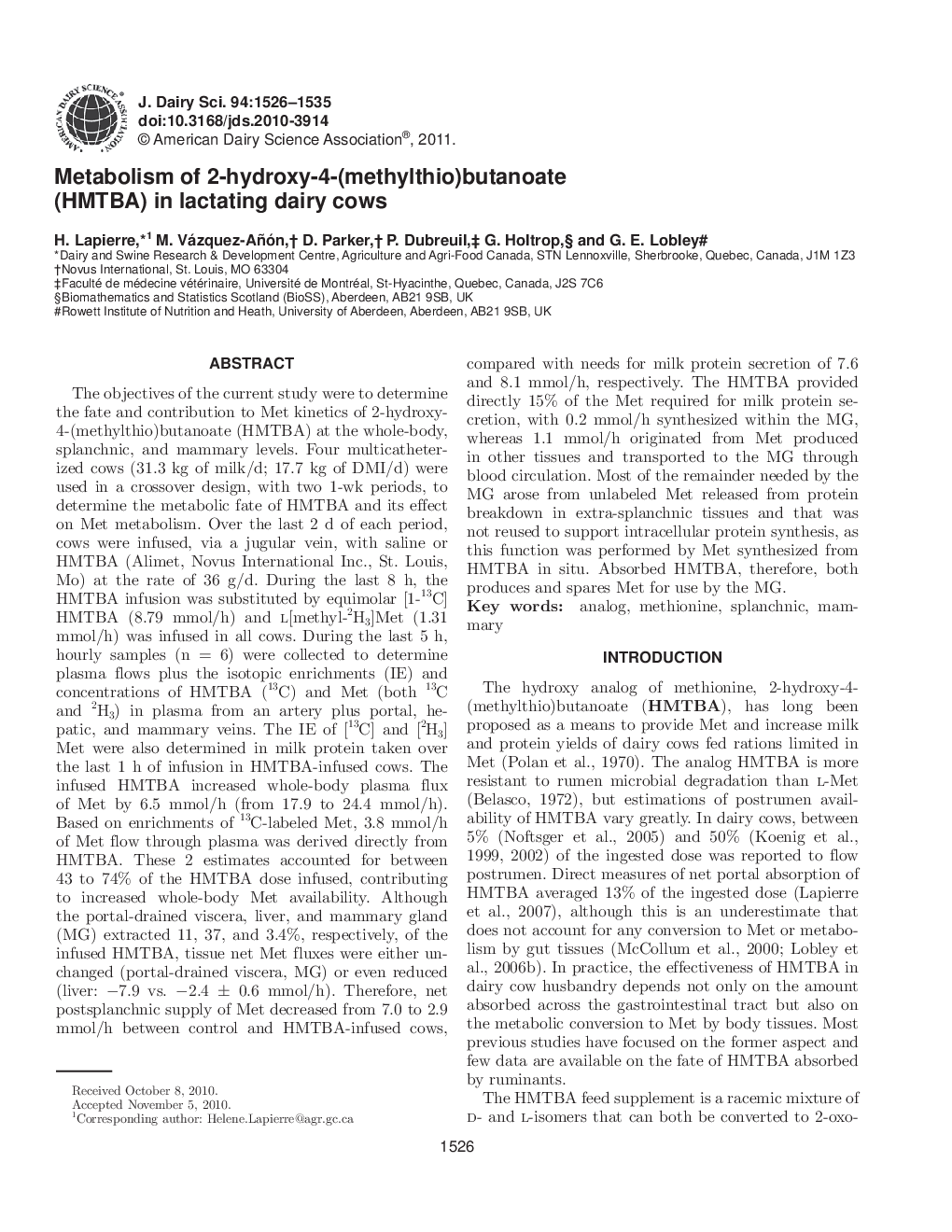| کد مقاله | کد نشریه | سال انتشار | مقاله انگلیسی | نسخه تمام متن |
|---|---|---|---|---|
| 10981435 | 1108076 | 2011 | 10 صفحه PDF | دانلود رایگان |
عنوان انگلیسی مقاله ISI
Metabolism of 2-hydroxy-4-(methylthio)butanoate (HMTBA) in lactating dairy cows
دانلود مقاله + سفارش ترجمه
دانلود مقاله ISI انگلیسی
رایگان برای ایرانیان
موضوعات مرتبط
علوم زیستی و بیوفناوری
علوم کشاورزی و بیولوژیک
علوم دامی و جانورشناسی
پیش نمایش صفحه اول مقاله

چکیده انگلیسی
The objectives of the current study were to determine the fate and contribution to Met kinetics of 2-hydroxy-4-(methylthio)butanoate (HMTBA) at the whole-body, splanchnic, and mammary levels. Four multicatheterized cows (31.3 kg of milk/d; 17.7 kg of DMI/d) were used in a crossover design, with two 1-wk periods, to determine the metabolic fate of HMTBA and its effect on Met metabolism. Over the last 2 d of each period, cows were infused, via a jugular vein, with saline or HMTBA (Alimet, Novus International Inc., St. Louis, Mo) at the rate of 36 g/d. During the last 8 h, the HMTBA infusion was substituted by equimolar [1-13C]HMTBA (8.79 mmol/h) and l[methyl-2H3]Met (1.31 mmol/h) was infused in all cows. During the last 5 h, hourly samples (n = 6) were collected to determine plasma flows plus the isotopic enrichments (IE) and concentrations of HMTBA (13C) and Met (both 13C and 2H3) in plasma from an artery plus portal, hepatic, and mammary veins. The IE of [13C] and [2H3]Met were also determined in milk protein taken over the last 1 h of infusion in HMTBA-infused cows. The infused HMTBA increased whole-body plasma flux of Met by 6.5 mmol/h (from 17.9 to 24.4 mmol/h). Based on enrichments of 13C-labeled Met, 3.8 mmol/h of Met flow through plasma was derived directly from HMTBA. These 2 estimates accounted for between 43 to 74% of the HMTBA dose infused, contributing to increased whole-body Met availability. Although the portal-drained viscera, liver, and mammary gland (MG) extracted 11, 37, and 3.4%, respectively, of the infused HMTBA, tissue net Met fluxes were either unchanged (portal-drained viscera, MG) or even reduced (liver: â7.9 vs. â2.4 ± 0.6 mmol/h). Therefore, net postsplanchnic supply of Met decreased from 7.0 to 2.9 mmol/h between control and HMTBA-infused cows, compared with needs for milk protein secretion of 7.6 and 8.1 mmol/h, respectively. The HMTBA provided directly 15% of the Met required for milk protein secretion, with 0.2 mmol/h synthesized within the MG, whereas 1.1 mmol/h originated from Met produced in other tissues and transported to the MG through blood circulation. Most of the remainder needed by the MG arose from unlabeled Met released from protein breakdown in extra-splanchnic tissues and that was not reused to support intracellular protein synthesis, as this function was performed by Met synthesized from HMTBA in situ. Absorbed HMTBA, therefore, both produces and spares Met for use by the MG.
ناشر
Database: Elsevier - ScienceDirect (ساینس دایرکت)
Journal: Journal of Dairy Science - Volume 94, Issue 3, March 2011, Pages 1526-1535
Journal: Journal of Dairy Science - Volume 94, Issue 3, March 2011, Pages 1526-1535
نویسندگان
H. Lapierre, M. Vázquez-Añón, D. Parker, P. Dubreuil, G. Holtrop, G.E. Lobley,